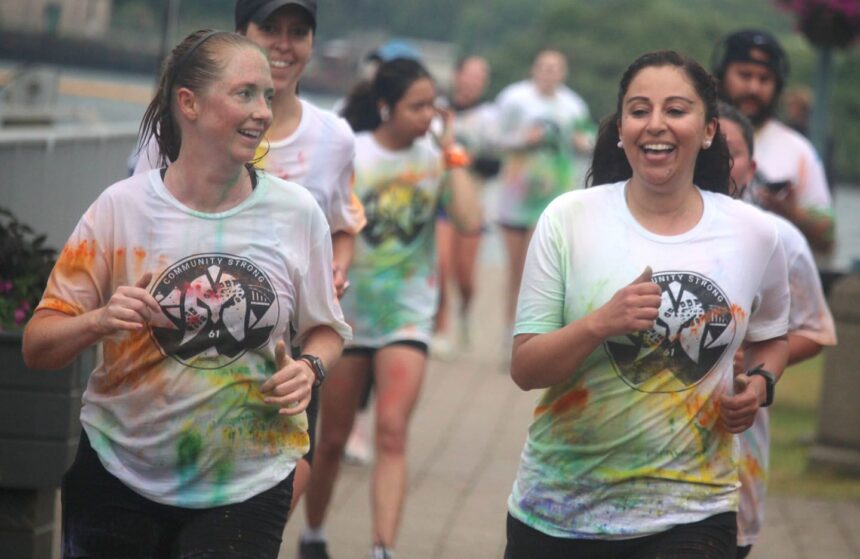The morning air bites at my cheeks as I watch dozens of runners gather at the Roberta Bondar Pavilion. Some hop in place to stay warm, others adjust their bibs, but everyone sports the same electric blue t-shirts emblazoned with “Moving for Mental Health” across the chest. It’s barely 7 a.m. in Sault Ste. Marie, but the energy buzzing through the crowd feels anything but sleepy.
“Five years ago, I couldn’t get out of bed most days,” says Jennifer McLeod, 43, adjusting her running shoes as we speak. “Now I’m organizing this whole thing. Sometimes I still can’t believe it.” Jennifer founded the Moving for Mental Health 5K three years ago after her own journey through severe depression. What started as a small group of twenty friends has blossomed into today’s event with over 300 participants.
The waterfront path offers stunning views of the St. Marys River, though most runners seem more focused on their conversation than the scenery. That’s precisely the point, according to Jennifer. “Running saved my life, but it wasn’t just the exercise—it was finding people I could actually talk to about what was happening in my head.”
Mental health services in Northern Ontario communities have long faced challenges of accessibility and stigma. According to the Canadian Mental Health Association’s Ontario division, northern residents wait an average of 16 months for specialized mental health care, nearly double the provincial average. Rural and remote communities face particularly steep barriers, with limited public transportation and fewer practitioners.
“We’re a resilient bunch up here, but sometimes that works against us,” explains Dr. Samantha Kearns, a clinical psychologist at Sault Area Hospital who volunteered at today’s run. “There’s still this notion that you should just push through tough times on your own. Events like this help normalize talking about mental health.”
Behind Jennifer, I notice a group of teenagers huddled together, all wearing matching bandanas tied around their wrists. They’re from the White Pines Collegiate student mental health alliance, formed after they lost a classmate to suicide two years ago.
“We’re not just running for ourselves,” says Elijah Morrison, a grade 11 student with the group. “We’re running for Jeremy, and for everyone who’s struggling but doesn’t know how to say it out loud yet.” His voice catches slightly, but he maintains steady eye contact. The teens have raised nearly $3,000 for local crisis services through bake sales and community bottle drives.
The Moving for Mental Health event splits its proceeds between the Sault Area Hospital’s mental health unit and the Canadian Mental Health Association’s local peer support programming. Last year they raised $27,000—not insignificant in a city of roughly 73,000 people.
As the runners take their marks, I notice Peter Akiwenzie, an Elder from Garden River First Nation, standing quietly nearby. He conducted a smudging ceremony earlier and now watches with evident pride. “Mental wellness isn’t separate from physical, spiritual, or emotional health in Anishinaabe teaching,” he tells me. “This run honors that connection in a beautiful way.”
Statistics Canada data shows that approximately one in five Canadians experiences a mental health problem or illness each year, but the numbers are likely higher in northern communities where reporting and access to diagnosis remain challenges. The COVID-19 pandemic only deepened the mental health crisis, with the Centre for Addiction and Mental Health reporting a 37% increase in anxiety symptoms among Canadians between 2020 and 2022.
The signal sounds and runners surge forward. I notice many people choosing to walk in pairs or small groups, deep in conversation. Several wear photos pinned to their shirts—loved ones lost to suicide or struggling with mental illness.
“My daughter wouldn’t come today, but she said I could run for her,” shares Martha Grenier, 56, pointing to the photo of a young woman pinned to her shirt. “She’s been hospitalized three times for her bipolar disorder. Each time it’s been harder to get proper care.” Martha pauses to greet another runner with a hug before continuing. “Events like this let her know she’s not forgotten, even when the system feels like it’s failing her.”
By mid-morning, the finish line buzzes with activity. Local businesses have set up booths offering everything from free water and protein bars to information about workplace mental health programs. Representatives from the Sault Ste. Marie Indian Friendship Centre provide materials about culturally appropriate mental health resources for Indigenous community members.
Jennifer crosses the finish line surrounded by friends, her face flushed with exertion and emotion. “When I was at my lowest, I couldn’t imagine a day like this,” she tells me, accepting a bottle of water from a volunteer. “Now I know that healing isn’t linear, but connection makes all the difference.”
The city’s mayor makes a brief appearance, presenting a certificate and announcing increased municipal funding for mental health first aid training for city staff. It’s a small victory in a much larger battle, but the crowd erupts in appreciative applause.
As participants begin to disperse, many linger to exchange phone numbers or make plans to meet for coffee. I overhear snippets of deeply personal conversations happening between relative strangers who now share a bond.
“Same time next year?” I ask Jennifer as she collects discarded water cups.
“Same time next month, actually,” she replies with a grin. “We’re doing monthly meet-ups now. Smaller, but just as important. Mental health isn’t a once-a-year conversation.”
The morning sun has finally warmed the pavilion as I pack up my notes. A handful of runners still circle the pathway, moving at their own pace. Some appear to be struggling, while others move with easy grace. From where I stand, they all look exactly as they should—like people taking one step after another, moving forward together.






